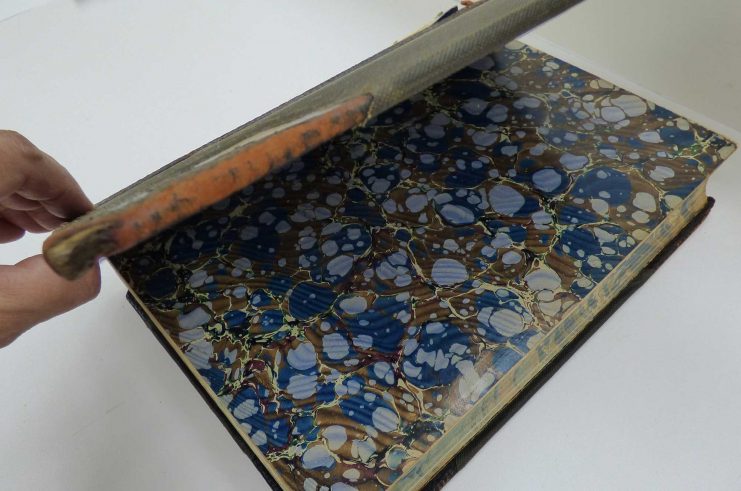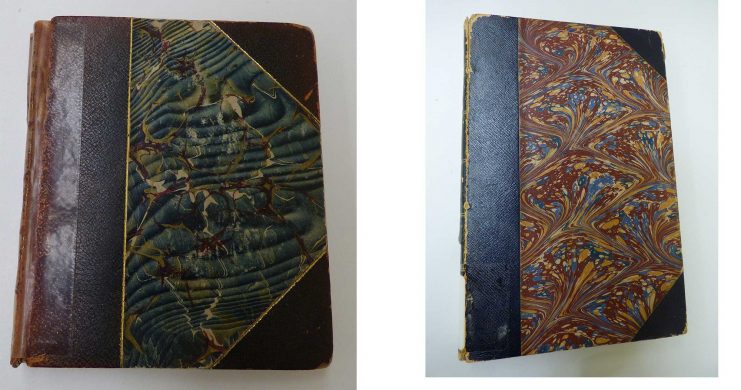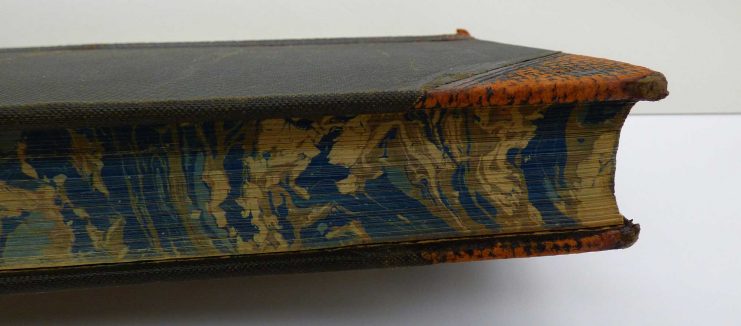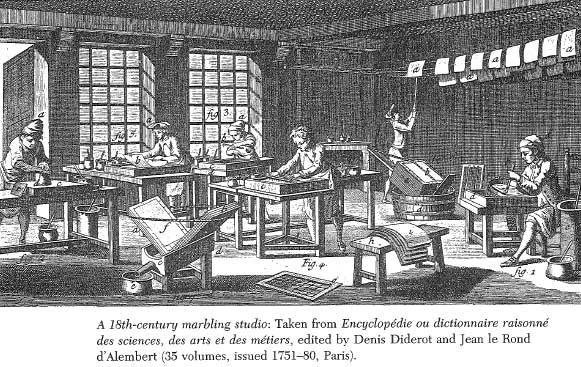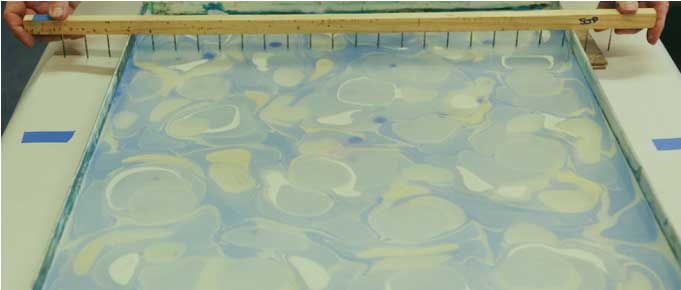By Laurie Jedamus
The quality of the content in our books is the primary reason why the Libraries’ Collection Management and Preservation Department repairs our circulating collections.
But look inside one of these books and you might be in for a surprise! Between their worn covers, many of these ordinary-appearing books have beautiful marbled endsheets.
While marbled paper in books was most commonly used for endsheets, marbled paper was also used on book covers.
Even the edges of a book can be marbled! The text block is clamped firmly and then the edges are dipped into a marbled bath. Edge marbling was not just decorative, but sometimes had a very practical purpose — the edges of account books from this period were sometimes marbled so that if pages were removed, the pattern would be interrupted and the removal would be obvious.
Once mechanical marbling became common in the late 19th century, the edges of books were marbled using rollers or (don’t try this at home!) by laying strips of marbled paper on the book edges, then saturating the strips with hydrochloric acid.
History of paper marbling
Paper marbling appears to have been developed in Turkey and the Middle East and was introduced to Europe, most likely by Venetian traders, in the 17th century. As was true for many trades from that period, paper marbling was a “secret art.” Only a few craftsmen knew how to make marbled paper, and they were reluctant to share their knowledge. As a result, some of their techniques and the knowledge of how to make certain patterns from that time have been lost.
Marbled paper was used for books, but also for other decorative purposes; linings for trunks, cabinets, instrument cases, and tea chests, to cover small decorative objects, and even as decoration for harpsichords. In the 17th century, production centered in France, Germany, and Holland. English bookbinders who wanted to use marbled paper for endsheets had an ingenious trick for avoiding the hefty customs duties levied on imported paper — toys and other small objects were wrapped in marbled paper for import. Once imported, the toys were unwrapped and the (untaxed) marbled wrapping paper was carefully smoothed out and sold to bookbinders.
Beginning around 1890, mechanical methods for marbling were introduced. They became common in the second half of the 19th century, and hand marblers became more and more rare. rediscovered.
How it’s done
Basic marbling technique is relatively simple, but it’s complicated by the fact that many factors can influence the final result, including the pigments used, the temperature of the room and and the size, the studio’s humidity, and the PH and the hardness of the water. Also, as many beginning marblers quickly learn, marbling design is a major factor in the final outcome. A beautifully executed sheet of marbled paper can suffer from a poor choice of colors or a too careful or overly haphazard application of pigment. It’s almost impossible to simply follow a “recipe” and get predictable results.
The first step in marbling is to prepare the paper. Paper for marbling must be treated with a mordant (usually alum) to make the colors permanent. Every beginning marbler learns this the hard way, when a beautiful pattern rinses right off a sheet of untreated paper, leaving just a pale shadow.
Pigment is then dripped or spattered onto the surface of a shallow tub of water. Since marbling pigments are heavier than water, size (a thickening agent such as gum arabic or carragheenan, made from seaweed) must be added to the water to keep pigments from sinking.
Colors are added one by one; each color pushes the previous colors out in irregular patterns. The pigments may then be combed (as the marbler in the photo above is doing) to create new patterns. The paper is then carefully laid onto the surface, quickly lifted off, rinsed to remove the size, and hung to dry.
Result: a beautifully marbled sheet of paper, ready to be used for endsheets or covers!
Watch for our next blog post for much more on marbling patterns!
Sources:
- The Art of Marbled Paper: Marbled Patterns and How to Make Them (1991), by Einen Miura
- Marbled Paper: Its History, Techniques, and Patterns (1990), by Richard J. Wolfe
- Sally Power’s blog


